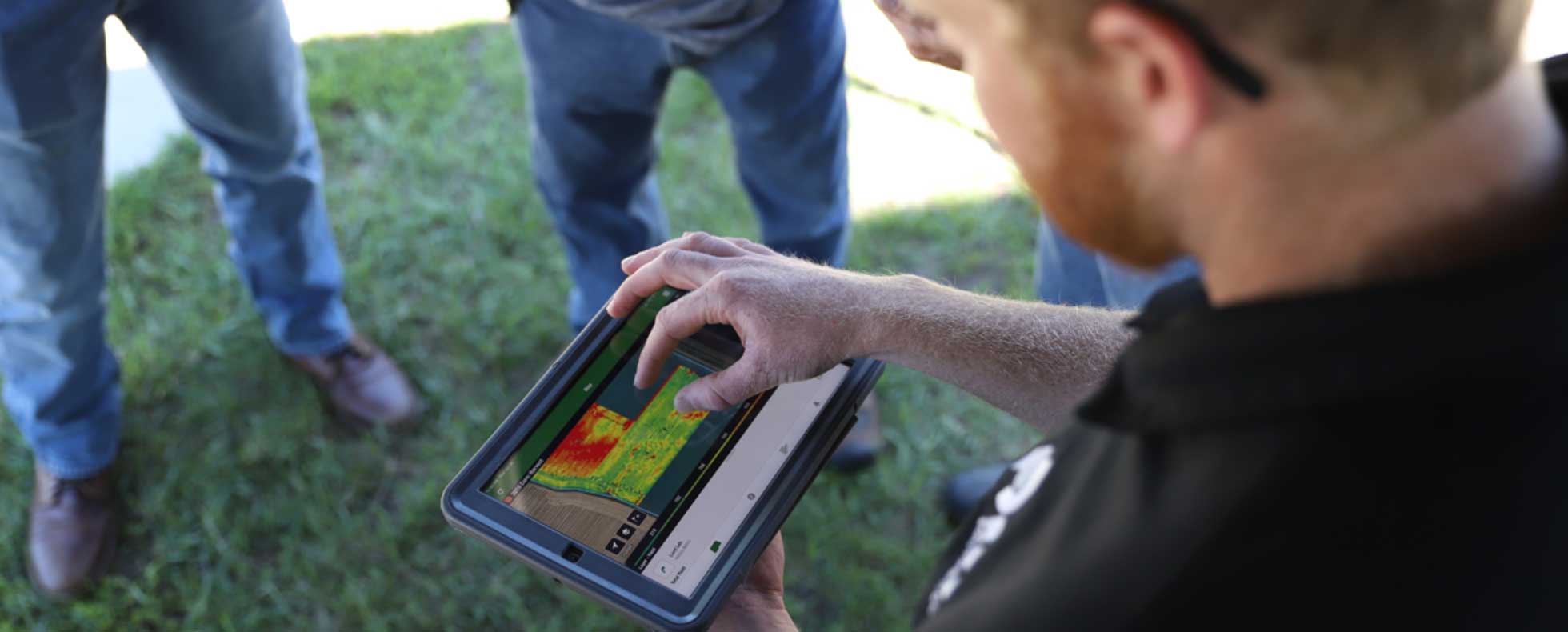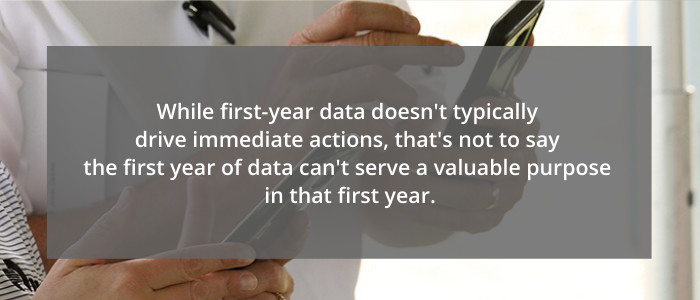
“It looks like something my five-year-old would draw!” the text message read.
It was from a producer I worked with who had just begun looking at his agronomic data in the data management system. And he wasn’t wrong.
It was NDVI imaging I collected from a Sentera sensor, a pockmarked picture of bright reds, yellows, and greens adorned an otherwise-pristine Google satellite image.
This was his first year using agronomic data, and both his initial and ongoing reactions lent themselves to a huge learning opportunity for both of us.
The First Year Struggle
I start out by sharing this story, first because it makes for a great one to illustrate examples of the key points I’ll discuss throughout this article, and second, because it’s a similar story I’ve seen with many growers – and, likely, every trusted advisor has experienced.
When growers first see the initial year of data, they might find that it is nothing more than a mess of colors and it may feel like no actionable or even usable information has been collected. Even growers who followed the steps for how to set up a good system for data collection from the start (as outlined in an article by one of my colleagues), often find the first data set to look confusing – or worse yet, be disappointing.
However, this can be avoided with the right expectations and mindset, and with the approach of building a long-term agronomic data foundation that leads to a sound decision management system.
First Year Expectations
Success doesn’t happen overnight, and knowledge isn’t instantaneous. The same is true with agronomic data.
Most agronomic data doesn’t drive immediate action the first year – plain and simple. It’s a fact that needs to be understood early on, and once the initial expectation of Archimedes (Eureka!) is out of the way, ongoing expectations of first-year data can be better managed.

Farming is an ever-changing environment where weather, seed quality, timing, and production efficiency all play into the success of a crop year-to-year, so it’s also wise to look at that first year with a grain of salt, because it will reflect the unique factors of that year. Also, the first year is important to establish a baseline of data to have a starting point for comparisons.
First Year Mindset
This leads to the next key piece to establish early-on, which is getting into the mindset of thinking about the data in terms of the next year or two, and what more could be learned.
Consider a similar situation I found myself in with my first-time data user grower. As we further developed our time in our technicolor-tract data, we started seeing that there may be longer-term trends in consideration. Soils samples came back showing some nutrients that were still sitting in the soil, indicating not fully utilized nutrients and that the field was performing as optimally.
The easy and initial thought was over-application of fertilizer. But rather than advising the grower to follow his knee-jerk reaction, which was to skip the area for nutrient application, I wanted him to think more. It could just have had a bad year in that spot due to pests, intermittent weather patterns, or a seed lot issue.
There are many times where using two to three years of data may avoid making harmful vs. beneficial data-based decisions.
Making Sense, Making Tweaks
My grower’s feelings of being overwhelmed and confused by the data – he was right. But his feelings that it was bad or wouldn’t work? Not quite. Because it was unreadable in the mapping system, he made the snap judgment that the data did not work, that something was wrong. So, we took a few initial approaches.
Start by looking at the data set and make sure it is processing correctly. For instance, going into the data, resetting Attributes Table/Bins, or by changing the sensitivity of the data is a quick way to get useable data. Certain data management programs may have a refinement set for creating “management zones” which normalizes the data and makes it easier to find larger trends.
In my, “Five-Year-Old finger painting” field case, using the management zone settings, we were able to make the data zones larger and less overwhelming through the data processing tools.
Next, a visualization exercise may help to ensure the data really is understood. Strive to process the data by visiting the field itself. If a piece of data seems impossible, scout fields after viewing it to help make sense of the data in a visual format.
Finally, make sure there was not, in fact, a data processing error. One more article, written earlier this year by my colleague, Jacob Maurer, is a great tutorial on how to clean bad agronomic data. Start adjusting out these errors, then go back to the data, and start doing the secondary comparison to the data as compared to the field application of nutrients, seeding rates, and other agronomic decisions.
First Year Hidden Value – Time
I’ve just spent the bulk of this article explaining why first-year data doesn’t typically drive immediate actions – but that’s not to say the first year of data can’t serve a valuable purpose in that first year.
I know, I know, I’m kind of going back on my own advice, but stay with me. There is non-agronomic data that can be collected and used to make that first year worthwhile.
In two previous articles I wrote, I highlight two specific examples of how good data can be useful, in terms of saving time and effort in data for acreage reporting and data for GlobalG.A.P. reporting. Whatever is needed to collect for banks, property owners, or agencies; precision ag and agronomic data collection can streamline the data reporting to those partners.

In my attempted “marker-mishap art project” field with my example grower, we started by processing reports that, after less than an hour, he was able to send to the FSA office via jump drive. The three hours he saved by not doing his acreage and county average reporting for FSA was a two hour net-positive that we could then spend on diving deeper in our agronomic data.
First Year Hidden Value – Expectations
The second piece of first-year value comes in a bit of a reality-check format. Even if growers go into it with reasonable expectations, when they see data that they don’t believe is refined enough for what they want to do with it or data that tells a different story than what they expect, they’re disappointed. But this could be the result of, again, misaligned expectations.
If the data wasn’t what was anticipated, it’s time to evaluate why it was disappointing, and what would have to change to see a result more aligned with his or her expectations. Sometimes, the disappointment isn’t because of the data itself – it’s because the data shows mistakes that have been made, and it can make the case to reconsider the management decisions made intra-field and inter-field.
In the case our Crayola-Creations field, we found a spot that was obviously never going to perform and hadn’t in the past, yet the grower had been continuing to invest in the area, hoping it would, eventually. His data disappointment came because, instead of the data helping him discover how to fix the area, it showed that the area wasn’t fixable. I advised that rock outcrop, with only a few inches of soil, may be better to be un-linked with the rest of the field and used for more economic purposes.
These types of conversations or reflections that challenge past decisions can be tough, no doubt. But there’s good action that can come from it.
In this example, my grower may have considered using the piece of land for a RTK tower and collecting rent, stacking straw from his wheat stubble, or other utilization of the space. We started talking about using the rocky area as a “Beneficial Insect Habitat”, enrolling it into his CSP Contract with NRCS and getting some points off a piece of ground under-performing anyway. The disappointment turned into a discussion of opportunity.
Setting Up for Success
There’s no getting around it – the first year of collecting and analyzing agronomic data is the absolute hardest and most emotionally-fueled year. It’s likely that thousands of dollars have been invested in equipment and annual subscription fees and the goal is to see those investments pay off. Additionally, data can expose mistakes made in the past.
This is a reminder not to get chained to data success in the first year and that mindset is a key to long-term growth. While difficult, the first year is also one filled with opportunities along with the challenges. Approaching it with an even head and analytical methodology is a crucial first step to avoiding disappointment and forging a path to long-term benefits in agronomic decision-making.
----------
About the Author
Erin Hightower has been working in farm planning and agronomy for 13 years. At RDO Equipment Co., she works with team members and growers in the Northwest region, focused on education and training, and conducting field trials. She’s a regular contributor to globalagtechinitiative.com, a Certified Crop Advisor (CCA), and Certified USDA NRCS Nutrient Management Planner, Certified Conservation Planner, and Comprehensive Nutrient Management Planner. Connect with her on Twitter @RDOErinH.
Learn more about precision agriculture from RDO Equipment Co. Browse listings of available used agriculture equipment for sale or find options by visiting your local RDO Equipment Co. store.